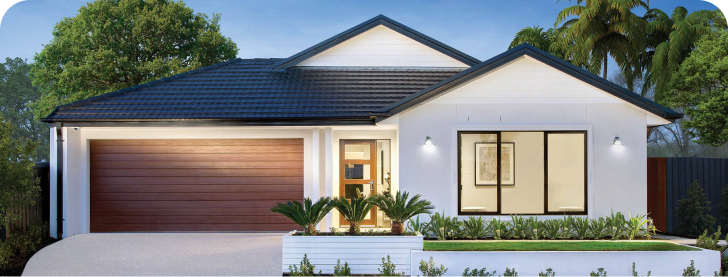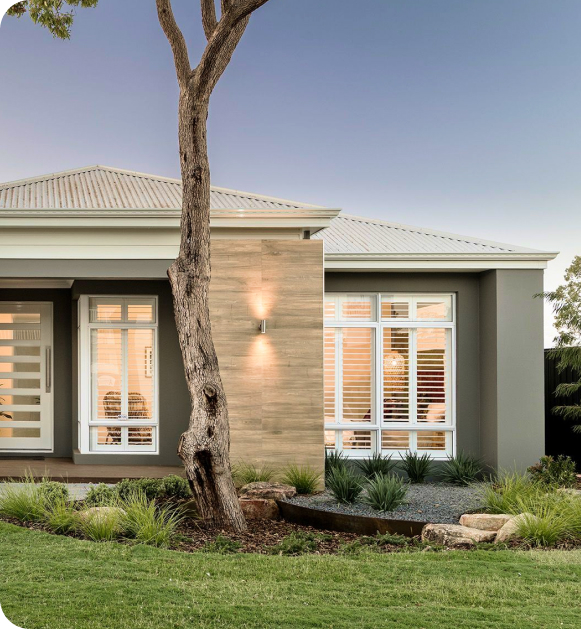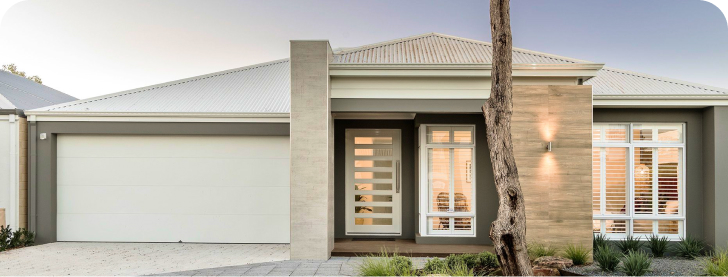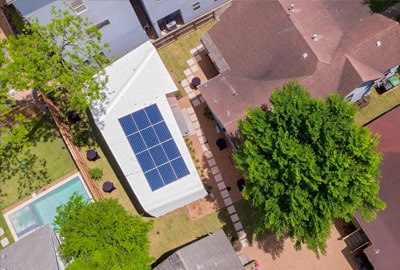
An accessory dwelling unit (ADU) is a type of living space that has gained great popularity in recent years. An ADU is a small, downsized home with all amenities built on the same plot of land as the main house. Homeowners choose ADUs when there's not enough space to house all family members, when they search for a source of rental income, or when they plan to resell the property.
By building accessory dwelling units, you help to reduce both the environmental impact and your own expenses. The compact size means less energy and less water waste, which leads to smaller utility bills.
But are there other sustainable practices that can be implemented during the ADU construction process to make your place of living more eco-friendly? Let's find out in this blog post!
By switching to renewable energy sources like sun and wind power, you scale down the need to use fossil fuels that cause harmful carbon emissions, which leave a carbon footprint in the atmosphere. Also, you help to diminish deforestation and improve the air quality.
When building an ADU, you can install solar panels on the roofs or put them in the backyard. In any case, employing solar panels in ADU construction leads to a reduction in your own energy use and, therefore, lower energy bills.
To build an eco-friendly ADU, property owners should pick sustainable building materials that reduce the environmental impact of their building and improve the overall wellness of the people in their neighborhood. Accessory dwelling units made with these materials are more durable and require less care than ordinary materials.
So, what are these sustainable building materials? They include:
In your accessory dwelling unit, you can make a glass door from recycled glass, a roof from recycled aluminum or recycled steel, recycled wood to build door frames, or recycled plastic to insulate your small house.
Many harmful chemicals are released into the air during the building stage. So, to make ADU construction more environmentally friendly and deteriorating for health, homeowners opt for paints and other finishes that contain only a small percentage of these chemicals.
For better water conservation, we offer rainwater harvesting systems. These systems are not suitable for drinking water, but they gather and accumulate rainwater for household use. For instance, pouring flower beds, washing garden tools, or flushing toilets
A greywater system is another way to use water sparingly. This system reuses water after washing in the washing machine or in the shower. It purifies the water to an extent where you can turn it into non-drinking utility water.
By implementing both of these technologies, you'll make your ADU more cost-effective as it significantly reduces your water waste.
A green roof for an accessory dwelling unit (ADU) is a layer of plants growing on an insulated roof. Not only does it give your ADU a forest-fairy look, but it also serves two practical purposes.
First of all, when you thermally insulate your ADU, it prevents air leakage. So you'll need less energy to keep the dwelling warm. An insulation layer prevents the heated air from escaping the rooms, and the intermediate layers prevent moisture from entering the roof inside.
Another function of a green roof is waterproofing. The plants on the roof absorb the stormwater and filter harmful pollutants out, preventing them from dripping down and forming polluted stormwater runoff.
So that you are able to have sustainable living in your ADU in the future, it makes sense to equip your accessory dwelling unit with energy-efficient appliances in advance. The key feature of energy-efficient devices is that they use less energy for working, but at the same time, they don't deteriorate your life's convenience.
Energy-efficient fixtures and appliances include:
Air conditioning, heating, and ventilation are vital for a healthy air state in the ADU. It helps to fight off summer heat and winter cold as well as purify the air, making it more suitable for people.
But how to choose an HVAC system that does not drastically affect your utility bills and is more environmentally friendly? Primarily, have a look at the types of HVAC systems, which are:
Heat pumps are the most energy-efficient equipment for air heating and cooling. They transfer hot air to a cold place and vice versa by moving it between the inside and outside of the house. However, sometimes they may not work well in cold climate zones. To pick a good heat pump, pay attention to the SEER rating, which indicates energy efficiency. It should be 16 or more.
Furnaces run on electricity, gas, oil, and other types of fuel. Furnaces heat up the air and then use ducts to transfer it all over the house. When picking a furnace, look at the AFUE rating. The closer it is to 100 percent, the more energy-efficient your furnace will be.
Split-system conditioners hang on the walls of your ADU and cool larger spaces than window or portable conditioners. To not make a mistake and choose more energy-efficient conditioners, base your choice on the recency of the model and SEER rating. You can also set it to a medium temperature, sufficient for a normal life, rather than a very cool one. For example, 73.4–78.8°F will be enough for lower utility bills.
After installing these energy-economic systems, you may also want to isolate your ADU from cooling out or heating up too fast once again. To do so, building companies offer to install dual-pane windows. This type of window preserves the temperature inside and, additionally, fosters outside noise reduction.
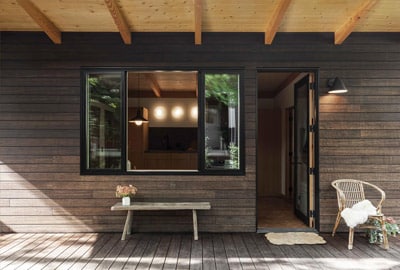
Natural light and air can come inside the accessory dwelling unit through windows, doors, and other types of ADU open spaces. To reduce energy waste on electricity, many ADU homeowners prefer to implement more such features into their home design.
So, what can be done with the light and airflow sources in the frames of accessory dwelling unit buildings to make these constructions more eco-friendly and to save money for their owners?
In the planning stage of your ADU project, make sure your windows and doors are arranged in such a way that light naturally penetrates into every nook and corner of your building. In addition, to enhance the lighting, you can arrange mirrors in the rooms so that they reflect light where it does not reach. As for natural ventilation, you should think about where the winds blow more often in your area and also be sure to place windows and doors opposite each other. So that the air passes through your entire house.
Create several large windows to better illuminate your property. Your door can also be transparent and thus serve as an additional light source. However, large windows are not appropriate for any room. For instance, in the bathroom, you can install small windows at the very top, closer to the ceiling. So, in the daytime, you will also be able to not use electricity there.
Aside from natural lighting, ADU homeowners who adhere to a more ecologically sustainable lifestyle prefer LED light bulbs instead of traditional ones. These bulbs last a long time and consume way less electrical energy. Moreover, in the evening, you can use all the solar power that the solar panels have accumulated during the day.
Anything from your food leftovers to natural scraps, fallen leaves, and any other natural materials that decompose quickly can be used to help the planet. When they turn into humus, they fertilize the ground and create a layer favorable for plant growth.
Fertile land is the key to a more sustainable future, so if you try and implement the following eco-friendly methods of waste reduction into your everyday life, it will help future generations a great deal.
Here we're talking about composting bins. Make one big or several small compartments if you don't want them to occupy much space on your property. Then, you just pile everything up and take it from the underneath opening when it's ready to become fertilizer.
There are many ways to contribute to water conservation, and one of them is by using fixtures with automatic control of water flow. You will be surprised at how much extra income the installation of such fixtures may bring annually.
The low-flow fixtures encompass:
Such toilets control the amount of water going into flushes with each use. Thus, if an ordinary toilet loses around 7 gallons of water per flush, a water-efficient toilet can utilize less than 2 gallons.
When ADU homeowners choose a faucet with a flow restrictor or aerator, it becomes impossible to waste more than it's supposed to. These technologies prevent water splashing and redundant water loss, reducing the amount of spent water by around 40%.
They work the same way as faucets. And, even though they decrease the harmful environmental impact, they are still able to provide a good showering experience. Such showerheads don't have lower water pressure when it comes to showering. The thing is, they use modern technologies that combine small holes and air to deliver water with the same force as traditional shower heads.
Smart monitors are devices that help you control energy use by providing data about energy consumption. They show you how much energy any appliance you're currently using takes and how much you're supposed to pay for it at the end of the month.
What exactly do these systems control and analyze? They show you the data concerning:
In the most eco-friendly ADUs, energy monitoring systems go hand in hand with energy optimization systems. Among the latter are energy plugs that can turn a device on and off depending on the need for it or the specific time you set up for it. Other means of energy control include smart thermostats. They are responsible for the HVAC system not overdoing its job when the desired temperature has already been reached.
All in all, installing smart energy use optimization systems contributes greatly to your welfare, both in material and environmentally sustainable ways.
Garage conversions are ADUs created on the same property lot as other existing homes. The process of their building is slightly different from a detached or attached ADU, yet there's no reason why you can't turn your unused garage into a green place for sustainable living.
The only thing you should do is pick a local business that engages in ADU eco-design and will take on your project.
If you design a green ADU, you'll want to make use of renewable energy sources like solar power. Thus, you need to properly position the solar panels on the house as well as properly orient the windows so that artificial lighting replaces natural lighting most of the day.
Also, when building an ADU, employ eco-friendly building materials and recycled materials as much as possible. Recycled materials are no less durable in many instances, especially if we talk about internal designs. They stand strong and simultaneously reduce harmful carbon footprints.
Concrete slab building or insulation will cost more or less the same. But the price ranges drastically depending on the exact materials used, types of water heating systems, sources of sustainable energy supply, the complexity of modern technologies you're going to use in your daily life, and many other factors.
Despite this fact, greenhouses are always worth it in the long run. When you've already spent money on their creation, they allow you to save greatly on your monthly bills. As you have to pay the bare minimum for utility bills.



